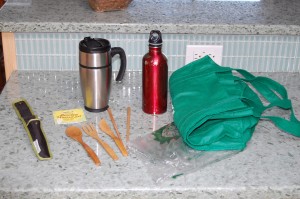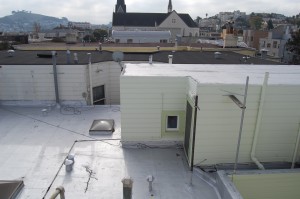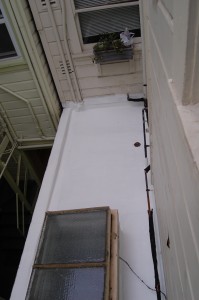I suppose a lot us think we’re pretty far removed from our explorer past – we don’t get up in the morning ready to hike through the wilderness, foraging for our food, looking for clean water to drink or shelter to warm up in if the elements are harsh.
Do we?
We do get up in the morning, but how many of you have everything planned out; where you are going to have lunch, what are you going to do when you need a drink, that sort of thing. I mean think about it – if you are looking for some cheap eats or you are thirsty in your cube, what are you going to do? Hit the vending machine? The water fountain? A local restaurant that sells pork siu mai 3 for $1.50?
We are all urban explorers in our civilized wilderness, and it makes sense to from a sustainable standpoint to act that way. I try and carry around this most days when I remember:

It is amazing how much waste this little urban camping get up reduces. The water bottle and coffee cup are pretty obvious – at this point everyone should know that bottled water is more expensive than regular tap – and San Francisco tap water is some of the best water you can drink world wide. So let’s be conservative and say that beat up red aluminum bottle replaces 100 plastic bottles each year, and it is 3 years old….
I drink at least a coffee a day 5 days a week, so over the course of a year that is about 250 of those little white lids I do not use, plus another 250 cups & cardboard cup sleeves and a whole bunch of those straw or wooden stirrer thingies (I just use one of my chop sticks)
The wooden utensils, aside from the just mentioned coffee stirring functionality, save on countless plastic knives/forks/spoons that come with whatever lunch I happen to scrounge up – be it cheap chow mein or a pasta salad, maybe some soup if it is especially foggy in the City.
The bags are a big one; San Francisco was the first large city in US to ban plastic bags from groceries – a brilliant move to keep them from ending up in the ocean among other places. And I give props to private companies like Whole Foods Market for offering brown paper bags instead of plastic for produce, that or reusing a plastic one both help us use less. Plus the reusable cloth bag is great for gathering or hunting: whatever tickles your fancy.
Now I screw up and forget my urban exploring kit from time to time, but whether it is the cup I do not use, or the bag I do not have to take, or the coffee stirrer thingy I replace with my chop stick, I feel a bit better about my day. It is not the end, but its another step in the right direction.


 Lots of different roof types and colors, the first looks like a silvery modified bitumen type, light colored but not white. The next is a black and then brown but still dark roofing material, and its the color alone that matters. Multiply those roofs over the whole city and that is some serious heat being trapped. According to many media outlets,so lets pick the
Lots of different roof types and colors, the first looks like a silvery modified bitumen type, light colored but not white. The next is a black and then brown but still dark roofing material, and its the color alone that matters. Multiply those roofs over the whole city and that is some serious heat being trapped. According to many media outlets,so lets pick the 